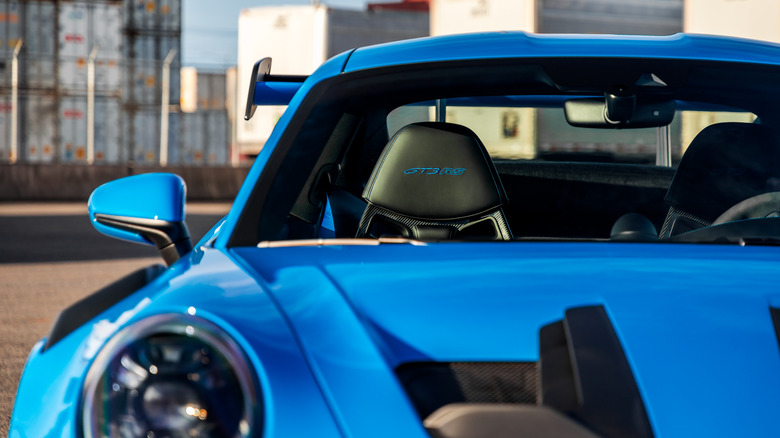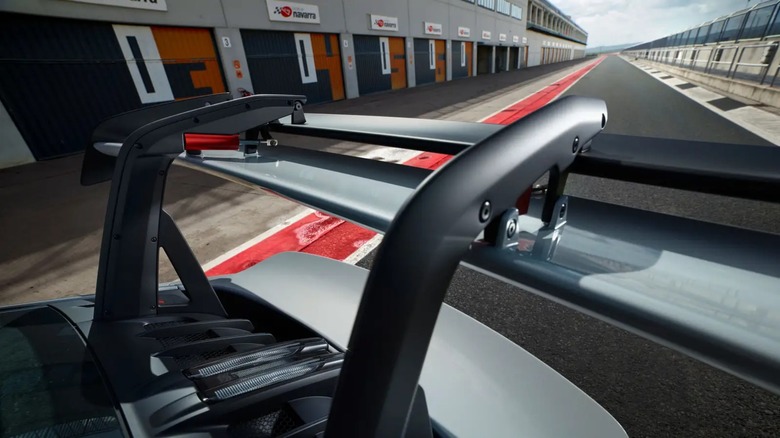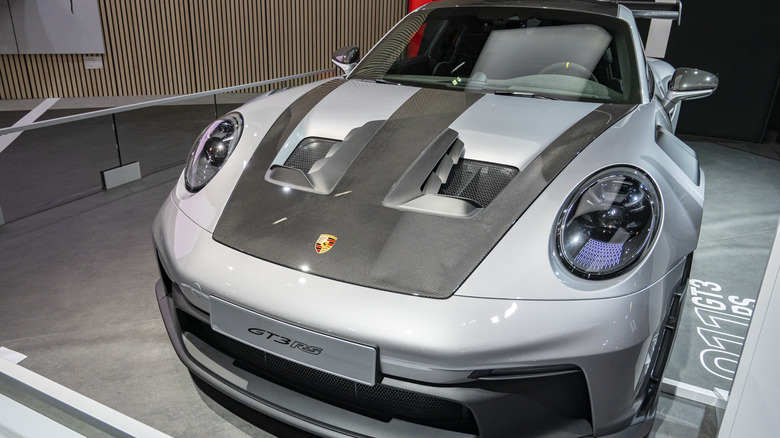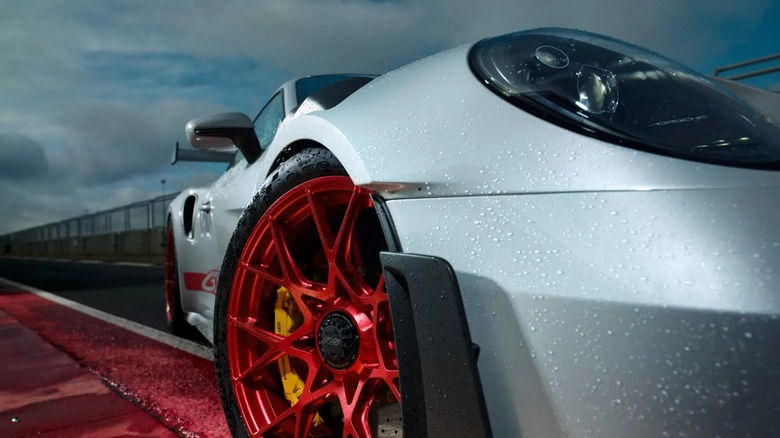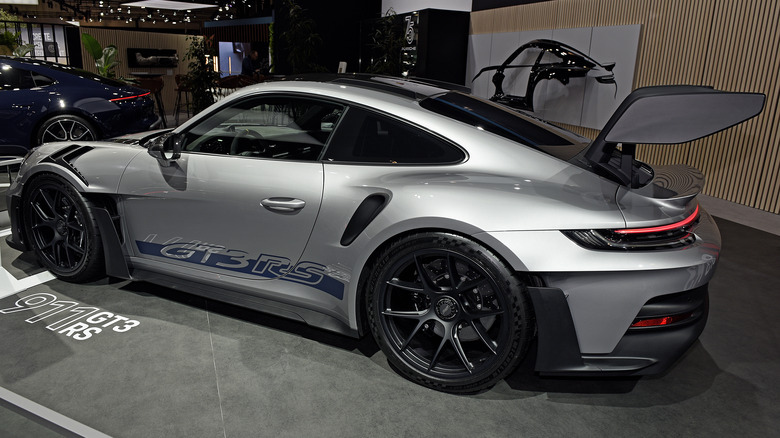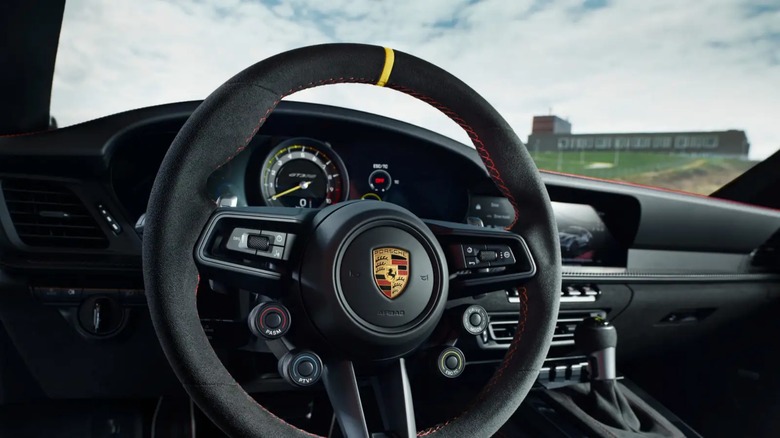10 Reasons Why The Porsche 911 GT3 RS Is Such An Expensive Vehicle
Porsche's offerings are expensive at the best of times, since the company manufactures high-performance vehicles, primarily sports cars. If you buy a Porsche, you're going to spend, on average, more than $100,000. While you can mitigate this price by purchasing older models, don't be surprised if you find Porsches that will set you back well over $700,000. One of the company's newest cars, the Porsche 911 GT3 RS, might not cost that downright sacrilegious amount of cash, but it's expensive nonetheless.
To call the Porsche 911 GT3 RS an update of the 911 GT3 would quite frankly be an insult to both the RS (short for Rennsport) and the designers behind it. While the GT3 is as at home on the track as it is on the road, the RS was designed almost exclusively for racing. The car is far more aerodynamic than the GT3 with triple the downforce — downward pressure that makes the car grip the road more and therefore allows it to travel faster. To achieve this, Porsche's designers almost completely redesigned the car from the ground up, with countless additions and remixed parts. While the Porsche 911 GT3 retails for as "low" as $182,900, the 911 GT3 RS starts at $241,300. And like other luxury sports cars, that price can (and will) balloon exponentially.
As you will learn throughout this article, the Porsche 911 GT3 RS is more expensive than the 911 GT3 for the same reasons it's faster than the 911 GT3.
An expensive engine
The engine is the heart of every car. The more powerful the engine, the faster it goes. However, top-of-the-line engines are not easy to make and cost a hefty sum. That cost is reflected in a car's price tag.
Much of Porsche 911 GT3 RS' power comes from its beastly engine. This 4.0-liter naturally aspirated engine cranks out a total of 518 horsepower and can rocket the car from zero to 60 in three seconds. The GT3 RS' top speed is clocked at 184 mph, but this belies an important question: Comparatively, the 911 GT3 has 16 less horsepower and takes 0.2 extra seconds to reach 60 mph, so what makes the GT3 RS' engine so much more expensive?
Admittedly, much of the GT3's engine was preserved to produce the GT3 RS' engine, but Porsche made key changes that required newly machined parts that were by no means cheap. New camshafts with new cam profiles were added; the gear ratio was shortened; air intakes were added to the bottom; and piston diameters and disc thicknesses were increased from 30 to 32mm and from 34 to 36mm, respectively. Plus, the engine's oil passages were redesigned to ensure oil does not pool at the high Gs the car and driver experience on racetrack turns.
Since the Porsche 911 GT3's engine was already a powerhouse that ate up the road (and a significant chunk of its buyer's wallet), it makes sense that the 911 GT3 RS' modifications would increase both its performance and price point. Unless the company figures out how to pull more performance out of weaker engines, don't expect subsequent GT3 RS models to decrease in price.
More carbon fiber than car
Cars are normally formed out of materials such as aluminum and steel. Some manufacturers try to use stronger materials, such as the Tesla Cybertruck and its cold-rolled 30X stainless steel. Tougher, yes, but also heavier. Porsche opted for a material that is hardier than steel and aluminum but also lightens the load on the car's wheels — almost as much as it lightens the wallets of customers.
For the 911 GT3 RS, Porsche constructed most of the car out of carbon fiber reinforced plastic (CFRP). This includes parts such as the doors, front quarter panels, hood, and the standard bucket seats. Even parts of the suspension, such as the sway bars, are constructed out of CFRP. Porsche's seeming obsession with CFRP is a huge contributor to the GT3 RS' price, since carbon fiber costs anywhere between $200 to $300 per kilogram, significantly more than standard car construction materials. The costs rack up quickly and are then passed on to customers, but for racing fans, it's a fair asking price.
Thanks to this alternative construction, the GT3 RS only weighs 3,268 lbs. This might seem like a downgrade compared to the Porsche 911 GT3's 3,164 lbs, but according to the tech specs, the RS is wider and longer, boasts wider wheels, and packs in additional components designed to maximize performance. That the vehicle doesn't weigh even more than it does can be attributed to its CFRP construction.
As technology improves, the production costs of CFRP and other carbon fiber parts will likely decrease. Perhaps one day the price of CFRP will drop to a point where the average driver can afford it, but for now, these cars and their futuristic building materials are reserved for people with money to spare.
The rear wing isn't just for show
Many cars include a spoiler, i.e., a big wing-like bar in the back. This add-on is designed to get rid of drag on a car, or to "spoil" it, hence the name. Spoilers can work when implemented correctly; the spoiler in the back of the Porsche 911 GT3 RS is far more advanced than the average trunk attachment.
The GT3 RS' rear wing is actually part of a Drag Reduction System (DRS) that is usually reserved for racing cars. The GT3 RS is the first mass-produced car to feature this system and its rear spoiler. Unlike most spoilers, the GT3 RS' rear wing isn't a static piece but a two-part component that can alter its shape, not unlike the wings of an airplane.
The GT3 RS' DRS wing is powered by two hydraulically-controlled motors and can change the wing flap's angle to improve aerodynamic stability and maintain downforce. This reduces drag when drivers gun it on straightaways, as well as making the car grip the road better and maintain speed during turns. While users can activate the DRS wing manually, it is also a smart component that activates automatically when the car exceeds 62 mph and 5,500 RPM. Plus, the wing can act as an airbrake in a pinch.
All the technology that goes into the rear wing — from the hydraulic motors to the sensors that let it monitor the car's speed, acceleration, and pedal position — is not cheap. Add in significant manufacturing costs since the wing is made of CFRP and is as wide as the car and tall enough to clear the roof, and you have a component that makes up a significant portion of the Porsche 911 GT3 RS' cost.
The car sacrifices storage space for performance
Traditionally, U.S. car manufacturers place the engine in the front and the trunk in the back, whereas many European manufacturers — Porsche included — reverse that order. However, the Porsche 911 GT3 RS deviates from this tradition by stuffing the front with expensive systems that squeeze as much performance as possible out of the engine.
The majority of the GT3 RS' front consists of one big central radiator. This design makes the radiator system, which cools the engine by absorbing its heat and exchanging hot air with cool air from outside, more efficient and optimized. Moreover, the extra-large radiator is oriented so the hot air flows down the sides of the car to avoid the engine intake. The last thing any car engine needs is to gulp in hot air, especially when it's already heating up under the stress of churning out 518 horsepower.
What little front space isn't taken up by the radiator is left for the front portion of the DRS. Two flap-like "wing elements" sit at the head of the car and continually adjust during a drive thanks to a system of sensors and motors. These components increase the downforce on the front axle and are synchronized to the rear "wing" portion of the DRS.
Not only are all these components expensive, but Porsche elected to place them in what would otherwise have been reserved for an inexpensively-manufactured empty space designed to hold luggage. Then again, putting a bag full of clothes in the 911 GT3 RS would only weigh it down and negatively impact lap times.
The suspension is highly specialized
A car's suspension helps provide a smooth ride. Without a working suspension, every bump and pothole would make drivers and passengers shoot around the interior like pinballs. Normally, a car's suspension more or less stays the same, and if it changes, it's time for a tune-up. Porsche decided each 911 GT3 RS driver should customize the suspension to their preferences.
As previously stated, the GT3 RS' carbon fiber construction extends to its sway bars, which makes the RS' suspension lighter and stronger (and more costly) than that of most cars. However, the RS' suspension specialization doesn't end there. Its double-wishbone front axle is far more aerodynamically efficient, to increase downforce in the front of the car. These modifications already cost a pretty penny, but again, that's just the beginning.
The GT3 RS also includes three driving modes: Normal, Sport, and Track. Drivers can switch between these performance modes with the press of a button and the twist of a knob. Moreover, drivers can adjust settings within each mode. The traction, shock compression and rebound, and locking force can be modified to fit the user's preference, all from the comfort of the driver's seat — no crawling under the car necessary. And yes, this "satellite control" was far from inexpensive.
The amount of time, effort, and money that goes into the suspension of a race car is already staggeringly high, but to give drivers with zero engineering skills the ability to modify that suspension without taking their hands off the steering wheel? That costs even more.
Countless bells and whistles are devoted to performance
The key to the Porsche 911 GT3 RS' performance isn't limited to its engine. Almost every inch of the car is dedicated to maximizing downforce and minimizing drag to ensure that no iota of horsepower gets wasted. Even seemingly inconsequential surface details help achieve this, and the cost of manufacturing them all adds up.
The main body of the GT3 RS is interrupted by occasional fins designed to direct airflow. These foils extend to the underbelly, where they decrease lift and increase downforce. And even though the wing in the back is meant to improve downforce and improve aerodynamics, it is only one part of the DRS system. Even before air hits it, roof fins redirect hot air from the radiator to keep it from being sucked into the intake.
The more you look at the GT3 RS' body, the more you will find little pieces of automobile architecture that push the car even further and faster without weighing it down. The rear quarter panel reduces air resistance at the back; the curved body behind the front wheels and the louvers above them improve arch ventilation, and the front and rear diffusers increase downforce.
Any one of these tangible performance boosters would increase the price of a car significantly due to machining costs, but factor in that Porsche piled on numerous additions, and with parts that were already made of expensive carbon fiber, no less. These kinds of decisions add up when it comes to price tags.
Porsche packs in performance packages
As previously stated, the Porsche 911 GT3 RS is a racing vehicle; high performance is its bread and butter. However, there is always room for improvement, assuming you can afford it.
Much like the Chevrolet Z06, Porsche offers an optional performance package that makes the car an even more formidable force on the racetrack. For an extra $33,520, customers can purchase the Weissach Package. The bundle's main draw is that it replaces several more parts with carbon fiber variants. This includes the roof, upper exterior mirrors, door grab handles, and even anti-roll bars and coupling rods. The Weissach Package also trades the regular wheels for magnesium ones, to unload a grand total of 33 pounds that would otherwise weigh down the car.
This lavish option does more than improve the GT3 RS' performance. Part of the price tag goes toward a leather interior with the "Weissach Package" logo adorning the seat headrests and dashboard trim (which can be purchased separately for $4,730). Furthermore, while the steering wheel can already control the car's suspension via attached knobs, the Weissach Package adds one more function. "Porsche Doppelkupplung" (PDK, German for "Porsche Double Clutch") shift paddles are installed on the rear of the steering wheel. These paddles use the power of magnets to make gear changes feel more precise, almost gamifying the process.
If you absolutely need to shave a few seconds off your lap record, the Weissach Package might not be so optional.
Everything plus the kitchen sink
While Porsche offers a performance package that exchanges even more parts for carbon fiber variants, these aren't the only costly additions. If you want to ride in leather-trimmed style, change the car's color, or even add a few miles to the 911 GT3 RS' range, you're going to have to write a bigger check.
When you buy a GT3 RS, you can customize the car before you finalize the purchase, and Porsche offers numerous options ranging from the cosmetic to the functional. For instance, Porsche sells the car in white, red, black, and yellow at no additional cost, but if you want it in gray, silver, or blue, you will need to shell out an additional $4,220. Customers can also buy special 3D-printed seats, park assist and traffic sign recognition systems, and even a secondary fuel tank.
Some add-ons are more superfluous than others, and some don't even contribute to the car's appearance. Would-be Porsche owners can buy leather pouches and bindings for their keys and owner's manual, and anyone who purchases the RS reserves the right to add a limited edition chronograph (a combination display watch and stopwatch) to their bill. Not only does this watch look fancy, but its stopwatch functionality helps racetrack enthusiasts time their laps. Oh, and we can't forget that buyers can pick up their cars at various Porsche headquarters for an additional fee.
To be fair, most cars come with customization options; it's just that the Porsche 911 GT3 RS' options are way more expensive than most.
Extra fees and taxes are part of the package
Generally speaking, the manufacturer's suggested retail price (MSRP) is a bit misleading. You think you will only spend $1 on something you purchase off the McDonald's Dollar Menu, but it's actually closer to $1.10 because of taxes. Car purchases are swarming with these kinds of additional expenses, and the Porsche 911 GT3 RS is no exception.
Anyone who purchases the GT3 RS will be hit by numerous taxes, including a luxury tax – Porsche estimates this at $27,000 or more, depending on attached add-ons. Moreover, while the RS can reach almost 200 mph, that horsepower comes at the cost of fuel efficiency, which means a hefty gas-guzzler tax.
In addition to taxes that are part and parcel of buying a luxury car, new purchasers also have to worry about fees. The destination fee (the cost it takes to deliver the car), registration and license fees, and initial insurance costs all must be dealt with, but that's only the beginning. Insurance only lasts as long as you pay for it, and since the GT3 RS is an expensive vehicle to begin with, insurance premiums will be higher than average. Add the cost of regular maintenance (on expensive CFRP parts, no less), as well as the constant need to fuel up the car, and owners will find their bank accounts quickly draining.
Granted, recurring fees are applicable to all cars, but the Porsche 911 GT3 RS racks up costs faster than most vehicles.
Additional parts and fees in Australia
There are many reasons to live in Australia. The good healthcare, high wages, and excellent schools are compelling arguments, but the country has some downsides. For instance, 20 of the planet's 25 most venomous snakes call the country home, but more importantly, expensive luxury cars cost even more money in Australia.
If you purchase the Porsche 911 GT3 RS in the U.S., you will have to spend at least $241,300, but according to reports, the GT3 RS is subject to a significant price hike when sold down under. In Australia, the car retails for $537,600 without any bells and whistles (presumably in AUD). However, this price doesn't cover on-road costs and other fees, which inflate the price tag even further.
Like other luxury sports cars, such as the Chevrolet Z06, this wallet-eating price increase is primarily the result of Australian taxes, such as the Goods and Services tax and luxury tax, but some of that extra cash goes toward additional features. According to Drive.com.au, each Australian GT3 RS comes standard with auto-dimming side mirrors, a front-axle lift system, tinted adaptive LED headlights, rear parking sensors, a reversing camera, a digital radio, and a tire repair kit. Most of these are optional and expensive add-ons in other countries. Thankfully, the Australian GT3 RS' engine is equivalent to the one sold in RS vehicles across the globe, albeit with slightly less horsepower but slightly more torque.
Is it really unfair to double the price of a car in Australia when that sticker price covers features that are exorbitant add-ons in other countries? That's a question for Porsche 911 GT3 RS owners down under to answer.
